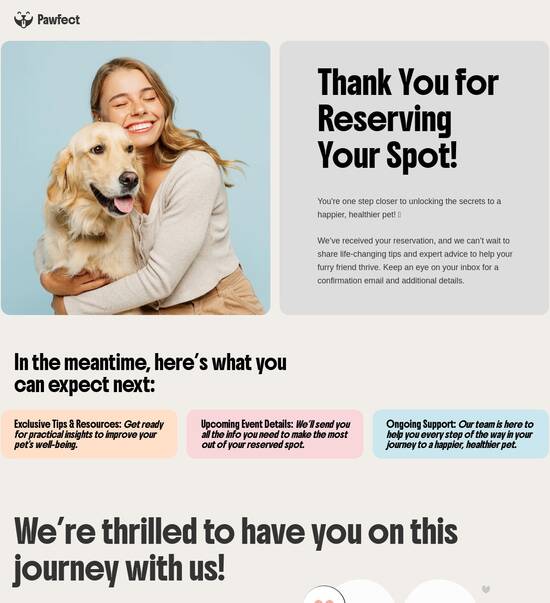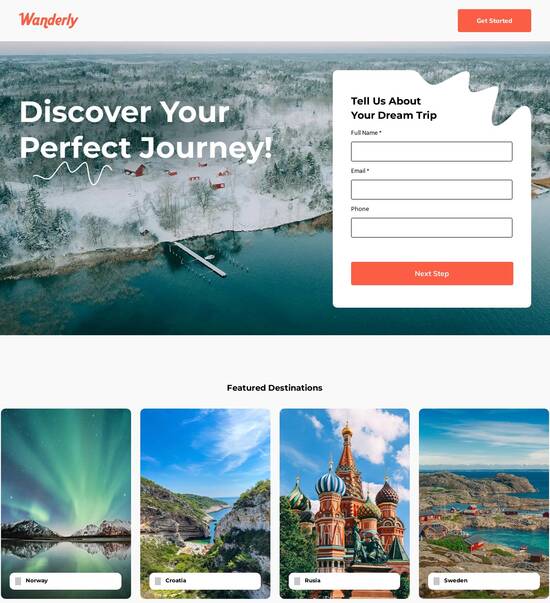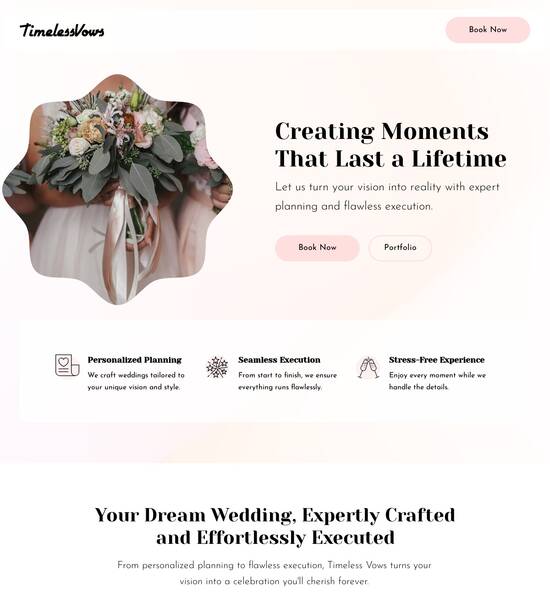
Bootstrap optimized privacy policy page template
Explore Similar TemplatesAbout template
Supercharge your privacy policy page with Bootstrap for outstanding performance! Learn more today.
Recommended templates

Easy to build without coding
With the intuitive drag-and-drop builder, anyone on your team can create high-converting pages without any knowledge of code or design. Make enhancements to your landing page with custom widgets using Javascript, HTML/CSS, or third-party scripts.

Multiple layouts for any industry and goal
Select from 500+ landing page layouts built to boost conversions across industry-specific scenarios. Customize them by adjusting fonts, adding images, and generating on-brand content with the AI assistant. Quickly scale with Instablocks® and Global Blocks that you can save, reuse, and update globally.

Loads fast and looks polished on any device
Every template is responsive, which means they present professionally on any device and load blazingly fast with our Thor Render Engine. You can also power them up with Google AMP technology to deliver an unparalleled mobile experience and drive higher conversions.

Robust analytics & experimentation
Get real-time updates and reporting across all your devices, showing the number of visitors, conversions, cost-per-visitor, and cost-per-lead. Launch AI-powered experiments, run A/B tests, and use heatmaps to analyze user behavior, then optimize your landing page to maximize conversions.







Easy to build without coding
With the intuitive drag-and-drop builder, anyone on your team can create high-converting pages without any knowledge of code or design. Make enhancements to your landing page with custom widgets using Javascript, HTML/CSS, or third-party scripts.
Multiple layouts for any industry and goal
Select from 500+ landing page layouts built to boost conversions across industry-specific scenarios. Customize them by adjusting fonts, adding images, and generating on-brand content with the AI assistant. Quickly scale with Instablocks® and Global Blocks that you can save, reuse, and update globally.
Loads fast and looks polished on any device
Every template is responsive, which means they present professionally on any device and load blazingly fast with our Thor Render Engine.
Robust analytics & experimentation
Get real-time updates and reporting across all your devices, showing the number of visitors, conversions, cost-per-visitor, and cost-per-lead. Launch AI-powered experiments, run A/B tests, and use heatmaps to analyze user behavior, then optimize your landing page to maximize conversions.
All the features you need to build bootstrap privacy policy template
Explore more featuresLearn how to build top-performing landing pages for any goal
FAQs
Leading the way in building high-performing landing pages





A comprehensive guide to Instapage for marketers
In today’s competitive digital landscape, utilizing the right landing page platform can significantly enhance your marketing outcomes. Instapage stands out as the top-tier landing page and Conversion Rate Optimization (CRO) platform, specially designed to boost your ROI, accelerate campaign effectiveness, and optimize your digital marketing strategies. This guide will take you through the essential steps to maximize your use of Instapage, ensuring both quick launches and sustained growth.
Understanding the power of Instapage
Instapage provides an all-in-one solution tailored for diverse industries, including business services, tech/SaaS, and financial services. By leveraging over 100 customizable templates, marketers can create attractive landing pages without extensive technical know-how. The platform's intuitive drag-and-drop builder simplifies the process, making it accessible for all team sizes, from startups to large enterprises.
- User-friendly interface: Instapage’s design empowers marketers to focus on strategy, not coding.
- Diverse templates: Choose from a library of conversion-focused layouts that cater to various industries.
- Lead generation tools: Access elements specifically designed to capture leads effectively.
Step-by-step guide to launching a landing page
Starting with Instapage is straightforward. Follow these steps to create compelling landing pages that convert visitors into leads effectively.
- Select a template: Choose a layout that best represents your brand and resonates with your target audience.
- Customize your page: Utilize the drag-and-drop functionality to make changes, add branding elements, and tailor the content.
- Preview and publish: Review your landing page across various devices for consistency before launching to the public.
Optimizing for conversions
Once your landing page is live, it is crucial to continually optimize it for better performance. Instapage offers built-in experimentation features to assist in this process.
- A/B testing: Compare different versions of your page to determine which performs better based on specific metrics.
- Heatmaps: Utilize visual data to understand user interaction and areas needing improvement.
- Analytics dashboard: Monitor traffic and conversion rates to make data-driven decisions.
Continual optimization and personalization are key to sustained success in digital marketing.
In summary, Instapage equips you with the necessary tools to create, launch, and optimize landing pages that drive results. By implementing the steps outlined in this guide, your marketing efforts will not only accelerate but also achieve greater scale and ROI.
Ready to begin your journey with Instapage? Start optimizing your digital marketing campaigns by signing up today and transforming how you capture leads and maximize ROI.
Bootstrap optimized privacy policy page template
Understanding the importance of a bootstrap optimized privacy policy page template
Creating a privacy policy page is essential for any organization that collects user data. A bootstrap optimized privacy policy page template not only safeguards the organization from potential legal issues but also enhances user trust. In an era where digital privacy concerns are persistent, companies need to be transparent about their data practices. By utilizing this template, organizations can present their policies in a clear, accessible format that users can understand.
The foundation of trust: why a privacy policy matters
Trust is the currency of the digital age. Users need to know that their personal information is taken seriously. A well-crafted privacy policy plays a crucial role in fostering this trust. When organizations communicate their data collection practices transparently, users are more likely to engage and share their information. Users expect their data to be handled responsibly, which increases the demand for clear privacy statements.
Transparency fosters trust and encourages user engagement.
A clear privacy policy aligns with user expectations in the digital landscape.
Legal implications of not having a privacy policy can result in fines and loss of credibility.
Key components of an effective privacy policy template
A privacy policy outlines how an organization manages user data, making it essential for users to understand their rights. An effective bootstrap optimized privacy policy template must contain several critical components. It should start with the expression of the purpose behind data collection, allowing users to comprehend why their data is needed.
Purpose of data collection: Explain why you're collecting data.
Types of user data collected: Detail the different data types gathered.
User rights regarding their data: Inform users about their data rights.
Data sharing practices: Clarify if and how data is shared with third parties.
Contact information: Provide a means for users to reach out with inquiries.
Moreover, it’s essential to write the policy in a user-friendly language. This fosters accessibility, ensuring that all visitors—regardless of their legal knowledge—can understand and navigate the privacy policy comfortably.
Designing for clarity: the user experience of privacy policy pages
The design of a privacy policy page significantly impacts the user's experience. A cluttered layout can confuse users, while a well-structured page can facilitate understanding. By using Bootstrap components, organizations can create an appealing and effective page that enhances readability.
Responsive design: Ensures the page is accessible on all devices.
Clear headings and bullet points: Allow users to scan for information quickly.
Engaging visuals: Infographics can simplify complex data.
Employing a conversational tone can demystify legal language, making it easier for users to grasp their rights and data practices.
Data collection practices: what users should know
Understanding the types of user data that websites collect is paramount for users. Information can range from basic identifiers like names and email addresses to more complex data such as browsing history and usage patterns. Organizations should explain their data collection rationale, highlighting the benefits both for the users—like personalized experiences—and for the organizations themselves.
For example, major organizations often demonstrate effective data management. They might employ thorough privacy policies that clearly outline their practices, thereby ensuring users feel secure. Such transparency not only builds trust but also encourages greater user engagement.
User rights: empowering individuals through information
Users have rights concerning their personal data, and a comprehensive privacy policy should inform them about these rights. Organizations must clearly explain these rights, including but not limited to, the right to access personal data, the right to request its deletion, and the right to withdraw consent at any time.
Right to access: Users can request copy of their personal data.
Right to deletion: Users can request the elimination of their data.
Right to withdraw consent: Provides users the ability to retract consent at any time.
Legal frameworks such as GDPR and CCPA support these rights, emphasizing the necessity for businesses to respect user privacy. Understanding and implementing these obligations is vital for bolstering user trust.
Ensuring compliance: navigating legal standards and regulations
Compliance with global regulations is non-negotiable. Non-compliance can result in serious repercussions, including hefty fines. Organizations must regularly audit their privacy practices against current legal standards. This includes updating their privacy policies to reflect changes in regulations, ensuring transparency and accountability.
Regular audits: Essential for ensuring privacy practices align with legal standards.
Education: Ongoing training for staff about changing laws is crucial.
Resources such as legal consultants can provide guidance in drafting a robust privacy policy that fulfills legal obligations and protects user rights.
Security practices: protecting user data in a digital world
Robust security practices are vital to protecting user data. Organizations must implement comprehensive strategies that include multiple layers of security measures to safeguard personal information. This aspect not only keeps users' data secure but also builds trust when users know their information is safe.
Access controls: Limit the number of individuals who can access personal data.
Data encryption: Protects data in transit and at rest from unauthorized access.
Regular security assessments: Identify potential vulnerabilities proactively.
Transparent communication about security practices also reassures users, encouraging them to share information with confidence.
Instapage's unique features: elevating your privacy policy template
Instapage offers customizable privacy policy templates designed to streamline the creation process. Its user-friendly interface allows marketers to modify templates according to their needs, ensuring that compliance with legal standards is met without sacrificing clarity.
Drag-and-drop interface: Facilitates easy customization without coding.
Pre-filled content suggestions: Helps users align with industry standards quickly.
Integrating a privacy policy template into Instapage's ecosystem can improve efficiency, allowing organizations to focus on user engagement and building trust.
Case studies: success stories of enhanced trust through privacy policies
Several organizations have successfully implemented optimized privacy policy templates, resulting in enhanced user trust and engagement. By analyzing their strategies, we can identify best practices that others can replicate.
Company A: Established clear data practices, increasing user signup by 30%.
Company B: Communicated robust data protection measures, significantly boosting trust scores.
These examples underscore the importance of clear and visible privacy policies in building strong relationships with users.
Future trends in privacy policies and user data management
As technology evolves, privacy policies must adapt accordingly. Emerging technologies such as AI and big data analytics present new data management challenges. Organizations need to stay ahead of these trends, providing transparency to meet evolving user expectations.
User expectations: A demand for greater control over personal data is continuing to grow.
Ethical data practices: Organizations will need to incorporate ethical considerations into their data policies.
Adopting these practices can foster brand loyalty and ensure compliance with changing regulations.
Engaging the reader: what to expect by implementing an optimized privacy policy
Implementing a bootstrap optimized privacy policy can yield tangible benefits for organizations. Such a policy enhances user trust, improving retention and reducing marketing costs. Additionally, clarity in data practices can significantly lower the risk of legal complications.
Enhanced user trust and retention through transparent practices.
Improved compliance, reducing the risk of legal issues.
Increased conversion rates as user confidence grows.
Reflecting on the journey: how to continuously improve your privacy policy
To stay relevant, organizations must regularly review and update their privacy policies. Gathering user feedback is vital for identifying areas needing improvement. Keeping abreast of evolving regulations ensures that the privacy policy continues to align with current legal standards.
Regular reviews ensure that policies stay current and relevant.
Encouraging user feedback invites suggestions for improving transparency.
Staying informed about changing regulations maintains compliance.
Through these strategies, businesses can foster a culture of transparency, ultimately enhancing user trust and loyalty.
Ready to skyrocket conversions?
Supercharge your ad campaigns with high-performing landing pages
Get started














